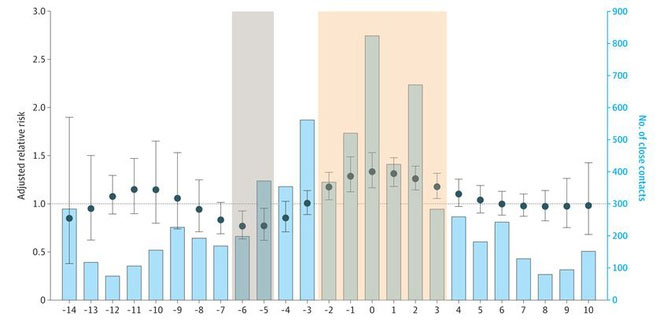According to research from a team of experts from the United States and China, the highest risk of transmitting the nCoV virus occurs two days before and up to 72 hours after the onset of symptoms in Covid-19 patients.
This finding was published in the JAMA Internal Medicine journal, conducted by a team of specialists at the Zhejiang Provincial Center for Disease Control and Prevention in China and the Boston University School of Public Health in the United States.
The project analyzed Covid-19 patients (confirmed by rRT-PCR testing) in Zhejiang Province from January to August 2020. According to Miami Herald, the authors identified 9,000 close contacts (F1) with 730 confirmed cases (F0). These individuals included housemates (friends, relatives), coworkers, hospital staff, and passengers who traveled with the mentioned F0 cases.
The research team monitored F0 cases for at least 90 days after they tested positive for nCoV. Among these, 89% of patients experienced mild to moderate symptoms, while 11% were asymptomatic.
The team discovered that individuals living with or repeatedly exposed to F0 cases had a higher rate of nCoV infection compared to other contacts. Notably, the risk was even higher for F1 contacts who were exposed to F0 at two critical times: two days before the onset of symptoms or three days after the onset of symptoms.

Description of the risk of nCoV transmission at the onset of symptoms in Covid-19 patients. (Photo: JAMA Internal Medicine).
The highest risk (peaking) occurs on day 0. This indicates that even just before the onset of symptoms, patients have the potential to infect and spread nCoV to healthy individuals. The period of highest SARS-CoV-2 transmission can last up to six days.
Additionally, the study found that if their F0 cases were asymptomatic, the subsequent F1 cases that contracted Covid-19 exhibited similar characteristics.
Therefore, the authors warn that when F1 contacts are exposed to F0 during this time and test negative on rapid tests, caution is necessary to avoid false negatives. F1 contacts should still self-isolate and monitor until they can undergo rRT-PCR testing.
According to Dr. Leonardo Martinez, an epidemiology professor at the Boston University School of Public Health, previous studies focused on the viral load or quantity of virus in the upper respiratory tract of F0 to predict their potential to spread nCoV. However, the research team from China and the United States discovered other evidence to explain why some F0 cases become super spreaders.
The key lies in the timing of symptom onset. The more people that come into contact with a patient during the time they are likely to spread nCoV, the faster and more extensive the risk of community transmission.
However, this study was conducted on the original nCoV strain – the one that emerged in Wuhan. Therefore, the researchers also acknowledged that they cannot confirm this finding with the Delta variant, which is believed to spread more easily and poses a higher risk of severe illness.
Another study published in The Lancet in November 2020 indicated that Covid-19 patients are most likely to transmit nCoV during the first five days after they are infected with the virus.
















































